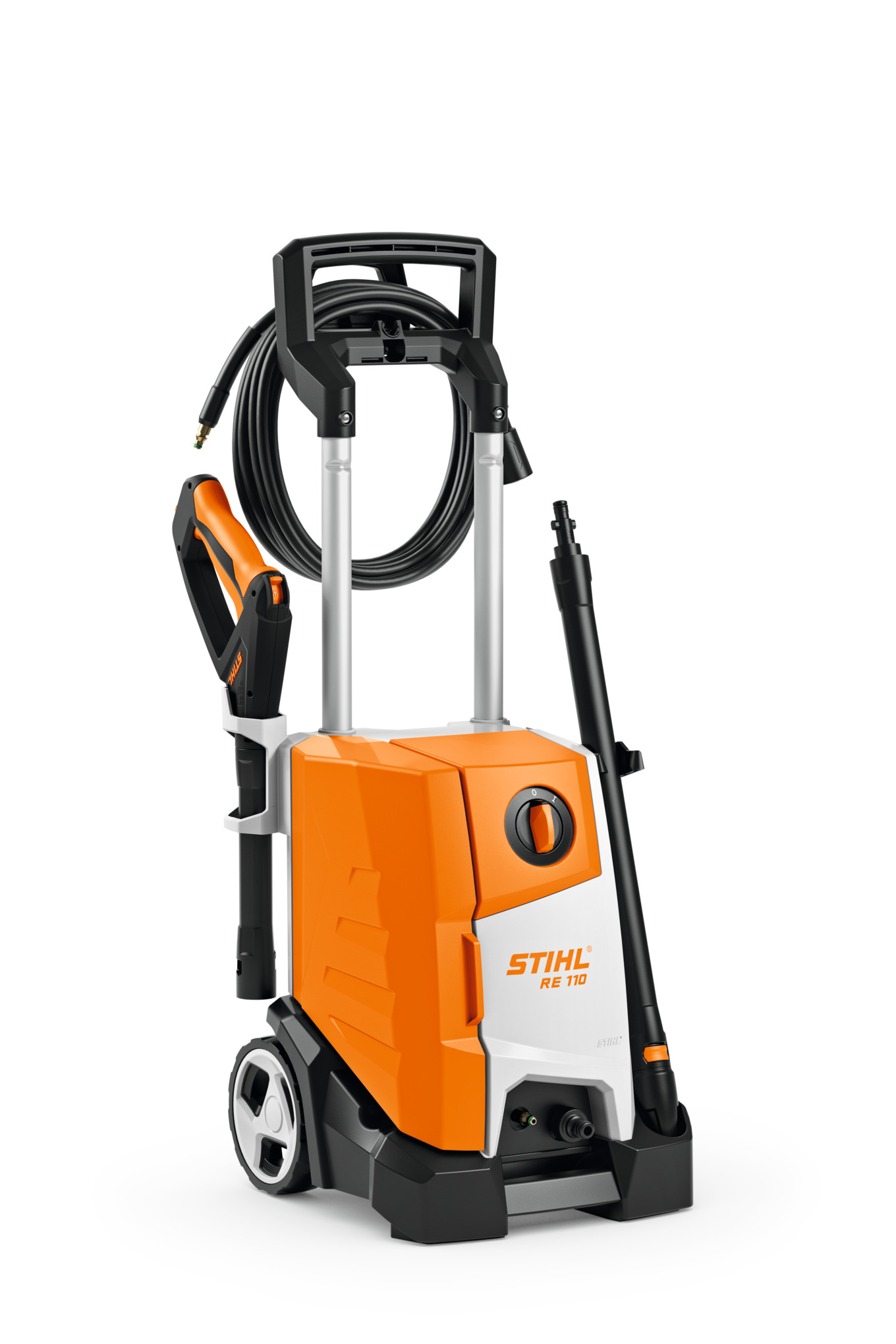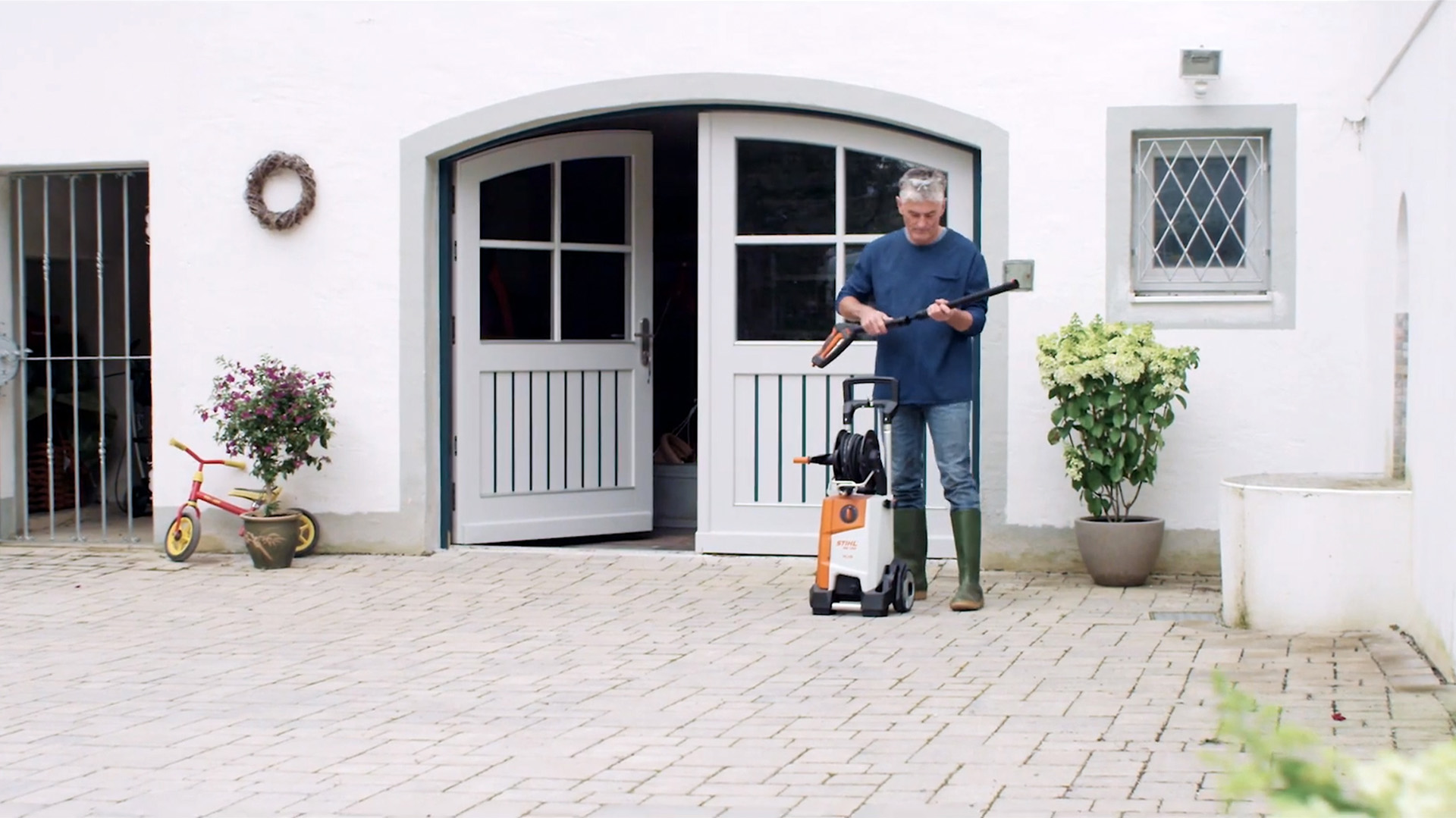Cleaning paving stones: useful tips for clean paths
Remove everyday dirt with simple methods – we will show you how to effectively clean outdoor domestic spaces.
09.04.2025

Cleaning paving stones: High-pressure cleaner
High-pressure cleaners are an effective way to remove dirt and weeds from your walkways. The high water pressure dissolves even the most stubborn dirt and cleans quickly and thoroughly, stone by stone. A high-pressure cleaner is particularly effective on large areas: the work gets done quickly and effortlessly.
A few general tips to consider when working with a high-pressure cleaner:
- not all paving stones can be cleaned with a high-pressure cleaner. Concrete and hard stone paving can be cleaned with low water pressure, for example with a surface cleaner. First, do a test clean in an inconspicuous area to see how the stones react and whether they are suitable for cleaning with a high-pressure cleaner.
- The surface cleaner works particularly gently and does not splash, meaning that the surroundings remain clean as you work. When using the fan jet nozzle, ensure that there is sufficient distance between the nozzle and the paving stones.
- Do not work in rainy or humid conditions.

Step 1: remove coarse dirt
Step 2: clean joints
Remove moss and weeds from the joints, as the roots will permanently damage the paving stones. Many people don’t know that using pesticides on paving stones is prohibited by law, because environmentally harmful chemicals can get into the soil and groundwater from there and pollute them.

For joints filled with grit or sand, it is best to work with a joint scraper or wire brush. A high-pressure cleaner can also be used on open joints. Simply refill the material that has been flushed out after cleaning. Closed joints can be cleaned easily with a high-pressure cleaner.
Remove weeds with high-pressure cleaner
Removing moss and weeds from joints can be tedious and time-consuming. Using a high-pressure cleaner makes it easier: organic matter can be cleaned with water pressure alone to save water and without the addition of cleaning agents. This means you can do yourself and the environment a favour.
Using a high-pressure cleaner for weed control delivers long-lasting results. The water jet penetrates between the individual stones and washes away not only the plants, but also their seeds, slowing down the growth of weeds.

Step 3: clean the paving slabs
Now that you have removed the coarse dirt and weeds, it’s time to clean the paving stones. For particularly heavy soiling, apply the cleaning agent directly with the high-pressure cleaner and leave it to take effect.

Step 4: refill joints
If too much material has been flushed out of the crevices during cleaning, you should refill them. This is important so that the paving stones do not subsequently move and form cavities.
Cleaning paved paths: legal requirements
Water used to clean paving stones may be contaminated with chemicals, acids and other pollutants. These must not be discharged into the sewer system or groundwater. In order to ensure this does not happen, the disposal of wastewater in Germany is regulated by statutory provisions. These vary from place to place, and in the event of a violation, fines may be imposed. Before cleaning your paving stones, you should check the applicable regulations with your local authority.
Cleaning paving stones: Domestic products
If you don’t have any stone cleaner at hand, you can use simple household remedies instead. Hot water, a soft brush and neutral soap are all you need to clean small areas. Soda crystals are also a proven dirt-busting agent. You should never add homemade household detergents to your high-pressure cleaner. The high-pressure unit should only be filled with a suitable cleaning agent.
Cleaning paving slabs with soda crystals
A mixture of soda crystals and water is an effective but strongly alkaline cleaning agent. It can be used for particularly dirty concrete blocks. Always wear safety goggles when working with this mixture, as soda crystals can irritate the eyes. You should also be sure to wear work gloves.
The amount of mixture you need depends on the surface to be cleaned. In general, you should use 10 grams of soda crystals per 1 litre of water. Spread the mixture over the paving stones with a broom and leave it to work for around 5 to 6 hours. Rinse the solution with clear water from the high-pressure cleaner or garden hose, being sure to comply with local waste water regulations.
Not recommended: cleaning patio slabs with vinegar
When cleaning paving stones with home remedies, vinegar is often a popular household cleaning agent for cleaning a variety of surfaces. However, it is not suitable for cleaning stones for the following reasons:
- acetic acid attacks joints between paving stones and can thus destabilise the substrate under the paving stones.
- Vinegar leaves light stains and should not be allowed to come into contact with limestone. This means that you should not use vinegar when cleaning concrete pavements or natural stone.
- Acetic acid irritates the respiratory tract and mucous membranes, so there is a risk of chemical burns if used improperly or if splashed.
To ensure that you can enjoy your high-pressure cleaner for a long time to come, the machine should only be filled with specially developed cleaning agents. STIHL offers a complete range of cleaning agents for high-pressure cleaners that are specially tailored to STIHL power tools.

Yes. STIHL cleaners can be used with or without a high-pressure power tool. The cleaning agents can easily be distributed manually using a sprayer. The ergonomic SG 11 Plus hand-held sprayer is ideal for this.

Cleaning paving stones: Special features of concrete and natural stone
How you clean your paving stones depends on their condition. Before cleaning, you should check which materials are used in your garden.
A distinction is generally made between concrete and natural stone.

Cleaning concrete blocks
Concrete blocks are the most commonly used paving stones and come in a variety of shapes. Compound stones can be cleaned with a surface cleaner. To check the compatibility of the stone surface, start with low water pressure and increase as needed.
Concrete stones can handle neutral and alkaline cleaning agents. However, they are made of acid-sensitive limestone and could be damaged if cleaned with acidic agents.
Removing limescale deposits
White spots on concrete pavements are perfectly natural, but some people find them irritating. They are typical in newly-laid stones and are nothing but excess limescale, which is released from the concrete after it is subjected to rain and moisture. These stains can be removed very easily and in an environmentally friendly way – with a broom, water and if necessary, a neutral cleaning agent.
Cleaning natural stones
Natural stone paving made of granite, marble, sandstone or basalt looks elegant and particularly high-quality. To maintain the beautiful appearance of the natural stone, you should only use pH-neutral cleaning agents. Acid and surfactants can damage the natural material.

Hard stone paving, such as granite, basalt and quartzite, is best cleaned with a high-pressure cleaner. These materials are robust and can withstand the high water pressure. Paths made of clinker bricks can also be cleaned with a high-pressure cleaner.
For softer materials, you should proceed carefully: you are on the safe side if you use lukewarm water, a soft brush and a neutral cleaner.
Summary: Cleaning paving Stones
- Pressure washers are the most effective way to remove dirt and weeds from your walkways.
- Start with low water pressure and test whether the stones are suitable for high-pressure cleaners by cleaning in an inconspicuous area first.
- Paving stones made of concrete and hard stone such as granite, basalt and quartzite, may be cleaned with a surface cleaner. Soft, porous natural stones should be cleaned gently with lukewarm water, a soft brush and a pH-neutral cleaner.
- Concrete and natural stone paving stones are sensitive to acid and must not be cleaned with vinegar.
- For the sake of the environment, you should only use biodegradable cleaning agents such as STIHL CS 100 Stone & FacadeCleaner.
- White spots on paving stones are natural limescale deposits, which occur especially commonly in new stones. After one to two years these will disappear by themselves. You can speed up this process by regularly washing the stones with water, a broom and, if necessary, a neutral cleaner.
- Closed joints can be cleaned easily with a high-pressure cleaner. A crevice scraper or wire brush is suitable for joints filled with grit or sand, Or you can also use a high-pressure cleaner. Simply refill the material that has been flushed out after cleaning.
- When using cleaning agents or maintenance products please comply with local waste water regulations.
- If you do not have a stone cleaner, use a neutral soap or, for concrete stones, a soda crystals and water mixture. Be sure to wear safety goggles, as soda splashes can irritate the eyes.



